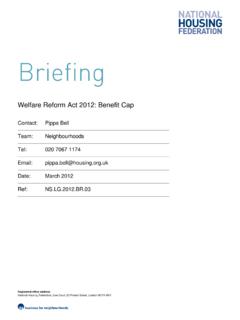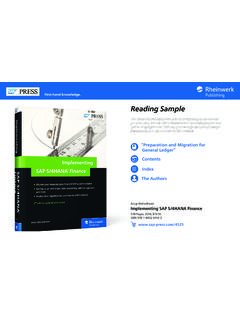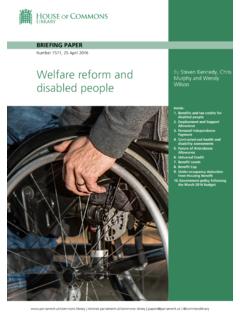Transcription of Briefing - Amazon Simple Storage Service
1 Page 1 Briefing - welfare reform Act 2012 : Direct Payments Briefing welfare reform Act 2012 : Direct Payments Contact: Sue Ramsden Team: Neighbourhoods Tel: 020 7067 1080 Email: Date: March 2012 Ref: Registered office address National Housing Federation, Lion Court, 25 Procter Street, London WC1V 6NY Page 2 Briefing - welfare reform Act 2012 : Direct Payments Introduction The Government plans to merge a number of means tested benefits including Housing Benefit, Income Support and Job Seekers Allowance into a new single benefit - the Universal Credit.
2 Apart from a small number of exceptional cases, Universal Credit will be paid monthly in arrears as a single payment to the household. Under these plans the Government wants to see many more social housing tenants receiving the money in their hand rather than opting to have their benefit paid direct to their landlord. The Government argues that this will help ease the transition into work by replicating a monthly salary. The Government s view is set out in a White Paper1 from 2010: There are advantages in paying the housing component to individuals, rather than the current system of payments direct to landlords.
3 This would encourage people to manage their own budget in the same way as other households. However, we also recognise the importance of stable rental income for social landlords to support the delivery of new homes and will develop Universal Credit in a way that protects their financial position. Options for achieving this could include some ongoing use of direct payments to landlords, use of direct debits, and a protection mechanism which safeguards landlords income. We will work closely with the devolved administrations, providers and lenders in developing the new system.
4 When will this happen? The Universal Credit will start from October 2013 for new claimants. Existing claimants will then be migrated across to the new benefit between 2013 and 2017, initially on the point of a change in circumstances such as moving house or the birth of a child. How many people will be affected? Chart 1: DWP estimate of split of social housing tenants affected by shift to payments to claimants2 1 Universal credit: welfare that works DWP Nov 2010 2 DWP Figures based on GB social housing tenant population Page 3 Briefing - welfare reform Act 2012 : Direct Payments Chart 1 gives an estimate of the split for Great Britain as a whole.
5 While the figures for working age claimants and older people are based on actual claimant numbers the figure of 10% for vulnerable people is a DWP estimate. This actual figure will depend on the definition and mechanism used to identify people. What will be the impact on landlords? The Federation has raised a number of concerns about the consequence of ending the choice to have the benefit paid direct to their landlord for many tenants. These are: Increased level of arrears and debt for tenants already living on low incomes Increased costs for landlords including: i) Arrears recovery, slower payment times and bad debt ii) Legal costs iii) Need for additional housing management staff iv) Need to support tenants and establish new payment collection methods v) Transaction costs Impact on the attitude of lenders to the sector A 2004 study3 by L&Q Housing Association in London of paying benefit directly to tenants found it arrears.
6 The rate of arrears as a proportion of the total rent roll increased from 3% to 7%. L&Q also identified additional transaction costs of 300,000 for its 16,500 tenants on housing benefit if 90% were to move to payments direct to tenants. They also estimated that they would need to process an additional 36,000 transactions a month and employ additional staff to manage the consequences of the change. The DWP has argued that if tenants are supported and the right financial products are available then direct payments to tenants should not have an adverse impact on landlords.
7 In September 2011, Lord Freud, 3 Where s the Benefit?, L&Q, February 2004 Page 4 Briefing - welfare reform Act 2012 : Direct Payments Minster for welfare reform , announced that DWP would establish about six small-scale demonstration projects to prepare for these changes. The DWP has stated that: The reason for having demonstration projects is to ensure we get the mechanisms, support and financial tools around this change right so landlords financial position is protected.
8 This means there should not be a negative impact on development. Where are the demonstration projects? The local authority and housing association partnerships named for the demonstration projects are: Southwark Council and Family Mosaic, London Oxford City Council and Oxford Citizens, (part of the) Greensquare Group, Southern England Shropshire Unitary County Council and Bromford Group, Sanctuary Housing and The Wrekin Housing Society, West Midlands Wakefield Metropolitan Borough Council and Wakefield and District Housing, Northern England Torfaen Borough County Council and Bron Afon Community Housing and Charter Housing, Wales A project in Scotland may be announced at a later date.
9 What will the demonstration projects test? The projects will be independently evaluated by a team at Sheffield Hallam University led by Professor Paul Hickman. Tenants who are part of the projects will receive their Housing Benefit in their hand as the default position. The projects will adopt the payment frequency envisaged under Universal Credit (monthly payments in arrears). The purpose of the demonstration projects will be to test: Trigger points for the rent to be paid direct to the landlord The impact of direct payments on claimants Mechanisms to protect vulnerable groups Mechanisms needed to support people with financial management Ways of communicating with tenants Strategies adopted to minimise the loss of income.
10 Will there be an arrears trigger? The DWP has stated that a trigger will operate to switch people in arrears onto direct payments. This could operate by number of payments, amount of money or length of time in arrears. Various forms of trigger will be tested by the demonstration projects. welfare reform Minister Lord Freud told housing associations in September 2011: Page 5 Briefing - welfare reform Act 2012 : Direct Payments The trigger will be there to protect landlords from persistent failure to pay and to reassure your lenders by providing a safety net so income streams remain secure.


















